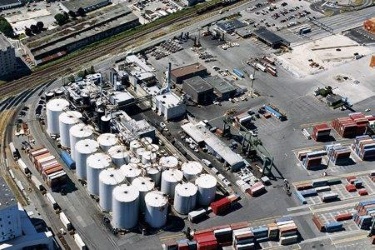
| July 15, 2014 | |
Capacity & Throughput: Lake Charles, Metro Vancouver
![]() Print this Article | Send to Colleague
Print this Article | Send to Colleague
A newly released study commissioned by the Port of Lake Charles forecasts Calcasieu Ship Channel vessel traffic will increase by more than 50 percent in the next five years and double by 2023 as a result of expanded operations of existing terminals and the construction of new facilities. A July 8 ceremony marked completion of work to expand the rail unloading capacity of the West Coast Reduction Ltd. facility in Port Metro Vancouver.
Lake Charles: Expanded Operations, New Facilities to Double Traffic in 10 Years
A newly released study forecasts Calcasieu Ship Channel vessel traffic will increase by more than 50 percent in the next five years and double by 2023 as a result of expanded operations of existing terminals and the construction of new facilities. The 36-mile, 42-foot deep waterway connects the Port of Lake Charles with the Gulf of Mexico. The study is the second in a series of three commissioned by the port.
The study used a detailed simulation model to assess the need for changes to the channel’s operation. The third report will identify the most productive changes and allow the port and other channel users to take steps that will minimized delays.
"The Calcasieu Ship Channel is vitally important not only to the Port of Lake Charles and surrounding industries that daily depend on access to it, but also to the entire country," said Port Executive Director Bill Rase. "This waterway handles nearly 55 million tons of cargo annually and is absolutely critical to supplying the nation’s energy needs."
The simulation model predicts annual traffic in the channel will increase from 1,000 vessels in 2013 to more than 2,000 in 2020. LNG carriers serving proposed terminals account for much of the increase.
Phase Two of the traffic study concluded that while the channel was capable of handling all of the additional traffic, vessels will typically experience higher wait times. Wait times were evaluated by vessel categories, and the wait time was highest for the most-restricted vessel categories – large LNG carriers and deep draft vessels.
Ernie Megginson, vice president of development for future channel user Magnolia LNG, said: "The Calcasieu Ship Channel connects Lake Charles to the rest of the world through the Gulf of Mexico. Magnolia LNG selected the site in Southwest Louisiana to build its 8 million ton per annum liquefied natural gas export facility because of the unique combination of location, infrastructure and transportation capabilities offered through the channel. This waterway is very important to our $3.5 billion project, and Magnolia appreciates the port leadership’s proactive approach."
Other conclusions reached by the traffic study relate to seasonal impacts and pilotage and tug requirements. The study determined wait times were highly seasonal and subject to wind and visibility. It concludes that additional pilots beyond the 17 currently employed will be required to handle the forecast traffic. It also concludes that the current fleet of channel tugs would suffice, providing that the LNG terminals relay on their own dedicated tugs.
"We plan to explore changes to channel operations and infrastructure that will allow the increased number of vessels to move more freely and reduce wait times for all vessels. Changes in traffic restrictions, new anchorages and passing lanes are possible considerations at this time," said Channing Hayden, the port’s director of navigation.
Metro Vancouver: Improved Infrastructure Boosts Port Facility Rail Car Loading Capacity
A July 8 ceremony marked completion of work to expand the rail unloading capacity of the West Coast Reduction Ltd. facility at Port Metro Vancouver.
West Coast Reduction is a producer of protein meals, fats and oils used internationally by feed, oleo-chemical and soap industries. Fats and oils produced at West Coast Reduction's plants in Alberta and Saskatchewan plants arrive via insulated rail tank cars at its bulk storage terminal, which is located on property the company leases from the port authority in the Burrard Inlet area of Vancouver harbor. According to the port authority, the terminal handles inedible tallow, feather meal, poultry meal, blood meal, fish meals and fish oil.
The rail upgrades will increase the number of railcars that can be unloaded simultaneously, from 16 to 24 and thereby boost the facility’s canola handling capacity by 50 percent. So doing, will improve transportation of agricultural products, particularly canola oil, being exported from Western Canada to Asia-Pacific markets.
Phases 1 and 2 of the Rail Unloading Improvement Project involve upgrades to the rail lines and to the piping system between the rail lines and pump house. These are now complete. Phase 3 will upgrade the piping system between the pump house and the marine vessel berths and is scheduled to be fully completed by March 2015.
The total project cost is approximately $11 million, with the Canadian government contributing up to $2.8 million under the Asia-Pacific Gateway and Corridor Transportation Infrastructure Fund (APGCTIF) and the balance to come from the company. The APGCTIF is part of the government’s Asia-Pacific Gateway and Corridor Initiative.

West Coast Reduction’s Vancouver Terminal.
Photo/West Coast Reduction, Ltd.
